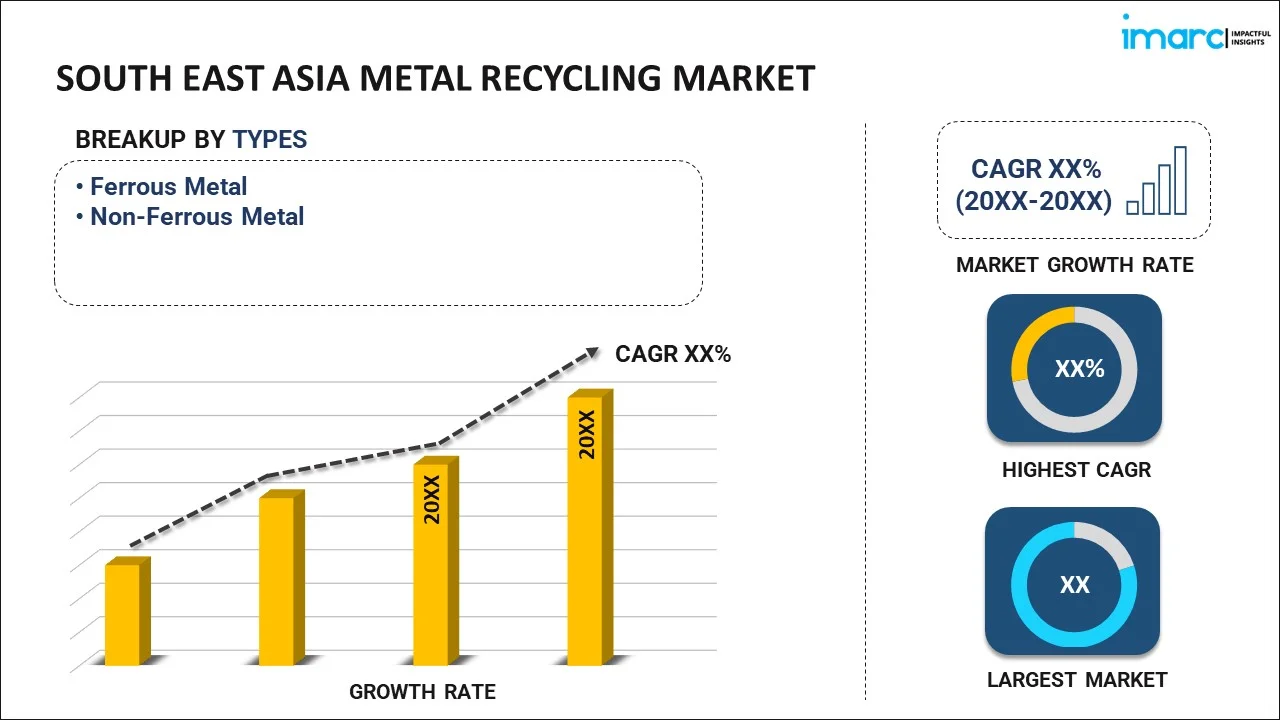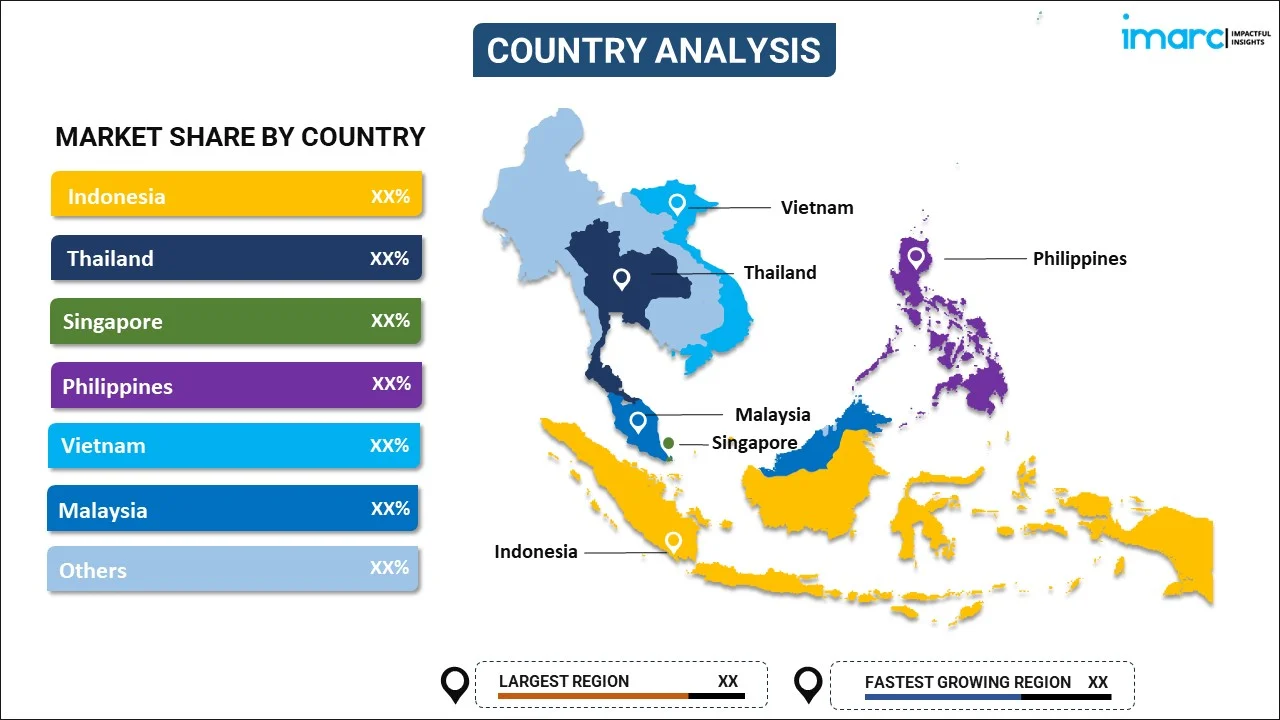
South East Asia Metal Recycling Market Report by Type (Ferrous Metal, Non-Ferrous Metal), End Use Industry (Building and Construction, Packaging, Automotive, Industrial Machinery, Electronics and Electrical Equipment, Shipbuilding, and Others), and Country 2025-2033
Market Overview:
South East Asia metal recycling market size is projected to exhibit a growth rate (CAGR) of 7.90% during 2025-2033. The growing advancements in sorting, processing and refining methods, rising collaboration among governing bodies, industries, and recycling firms, and increasing implementation of stringent environmental regulations to reduce pollution and carbon emissions represent some of the key factors driving the market.
|
Report Attribute
|
Key Statistics
|
|---|---|
|
Base Year
|
2024 |
|
Forecast Years
|
2025-2033
|
|
Historical Years
|
2019-2024
|
| Market Growth Rate (2025-2033) | 7.90% |
Metal recycling is the method of collecting, processing, and reusing various metallic materials, such as aluminum, steel, copper, and brass, to create new products. It is primarily of two types, including ferrous recycling, involving iron and steel, and non-ferrous metal recycling, including other metals. It is an environmentally responsible practice that involves several key aspects, including the collection of scrap metal from various sources like discarded appliances, vehicles, and construction materials. It significantly lowers the need for raw materials and conserves natural resources, as manufacturing new metal products from ore is energy-intensive and can lead to environmental degradation. It lessens greenhouse gas emissions and reduces the strain on landfills, as metal items often take decades or even centuries to decompose. Moreover, recycling metals like aluminum and copper can yield significant energy savings compared to mining and refining these materials from scratch. It is utilized across various industries, ranging from construction and automotive to packaging and electronics.
South East Asia Metal Recycling Market Trends:
At present, the increasing implementation of stringent environmental regulations to reduce pollution and carbon emissions represents one of the crucial factors propelling the growth of the market in South East Asia. These regulations are prompting industries to adopt eco-friendly practices, including metal recycling. In addition, the growing advancements in sorting, processing, and refining methods to improve the efficiency and quality of recycled metal products are offering a favorable market outlook. These technological advancements make recycling a more attractive option for industries seeking high-quality raw materials. Besides this, the rising adoption of the circular economy model, which encourages the reuse and recycling of materials to reduce waste and promote sustainability, is supporting the market growth in the region. Metal recycling is a major component of this approach, and it is gaining traction as part of broader efforts to minimize resource depletion and reduce the environmental impact of production. Additionally, the increasing collaboration among governing bodies, industries, and recycling firms, aiming to streamline the metal recycling process, improve collection and sorting infrastructure, and create a more efficient supply chain for recycled metals, is bolstering the market growth. Apart from this, the growing investments in recycling infrastructure, including collection centers, processing plants, and transportation networks, are contributing to the market growth in the region. These developments aim to address the challenges associated with metal recycling, such as the collection and transportation of scrap metal. Furthermore, rising innovations in collection methods, such as the deployment of smart bins and digital tracking systems, are making it easier to gather recyclable materials efficiently. These advancements reduce the cost and effort needed for collecting scrap metal, making recycling more accessible to a broader range of stakeholders.
South East Asia Metal Recycling Market Segmentation:
IMARC Group provides an analysis of the key trends in each segment of the market, along with forecasts at the regional and country levels for 2025-2033. Our report has categorized the market based on type and end use industry.
Type Insights:

- Ferrous Metal
- Non-Ferrous Metal
The report has provided a detailed breakup and analysis of the market based on the type. This includes ferrous metal and non-ferrous metal.
End Use Industry Insights:
- Building and Construction
- Packaging
- Automotive
- Industrial Machinery
- Electronics and Electrical Equipment
- Shipbuilding
- Others
A detailed breakup and analysis of the market based on the end use industry have also been provided in the report. This includes building and construction, packaging, automotive, industrial machinery, electronics and electrical equipment, shipbuilding, and others.
Country Insights:

- Indonesia
- Thailand
- Singapore
- Philippines
- Vietnam
- Malaysia
- Others
The report has also provided a comprehensive analysis of all the major regional markets, which include Indonesia, Thailand, Singapore, Philippines, Vietnam, Malaysia, and Others.
Competitive Landscape:
The market research report has also provided a comprehensive analysis of the competitive landscape in the market. Competitive analysis such as market structure, key player positioning, top winning strategies, competitive dashboard, and company evaluation quadrant has been covered in the report. Also, detailed profiles of all major companies have been provided.
South East Asia Metal Recycling Market Report Coverage:
| Report Features | Details |
|---|---|
| Base Year of the Analysis | 2024 |
| Historical Period | 2019-2024 |
| Forecast Period | 2025-2033 |
| Units | US$ Million |
| Scope of the Report | Exploration of Historical and Forecast Trends, Industry Catalysts and Challenges, Segment-Wise Historical and Predictive Market Assessment:
|
| Types Covered | Ferrous Metal, Non-Ferrous Metal |
| End Use Industries Covered | Building and Construction, Packaging, Automotive, Industrial Machinery, Electronics and Electrical Equipment, Shipbuilding, Others |
| Countries Covered | Indonesia, Thailand, Singapore, Philippines, Vietnam, Malaysia, Others |
| Customization Scope | 10% Free Customization |
| Report Price and Purchase Option | Single User License: US$ 3699 Five User License: US$ 4699 Corporate License: US$ 5699 |
| Post-Sale Analyst Support | 10-12 Weeks |
| Delivery Format | PDF and Excel through Email (We can also provide the editable version of the report in PPT/Word format on special request) |
Key Questions Answered in This Report:
- How has the South East Asia metal recycling market performed so far and how will it perform in the coming years?
- What has been the impact of COVID-19 on the South East Asia metal recycling market?
- What is the breakup of the South East Asia metal recycling market on the basis of type?
- What is the breakup of the South East Asia metal recycling market on the basis of end use industry?
- What are the various stages in the value chain of the South East Asia metal recycling market?
- What are the key driving factors and challenges in the South East Asia metal recycling?
- What is the structure of the South East Asia metal recycling market and who are the key players?
- What is the degree of competition in the South East Asia metal recycling market?
Key Benefits for Stakeholders:
- IMARC’s industry report offers a comprehensive quantitative analysis of various market segments, historical and current market trends, market forecasts, and dynamics of the South East Asia metal recycling market from 2019-2033.
- The research report provides the latest information on the market drivers, challenges, and opportunities in the South East Asia metal recycling market.
- Porter's five forces analysis assist stakeholders in assessing the impact of new entrants, competitive rivalry, supplier power, buyer power, and the threat of substitution. It helps stakeholders to analyze the level of competition within the South East Asia metal recycling industry and its attractiveness.
- Competitive landscape allows stakeholders to understand their competitive environment and provides an insight into the current positions of key players in the market.
Need more help?
- Speak to our experienced analysts for insights on the current market scenarios.
- Include additional segments and countries to customize the report as per your requirement.
- Gain an unparalleled competitive advantage in your domain by understanding how to utilize the report and positively impacting your operations and revenue.
- For further assistance, please connect with our analysts.
 Inquire Before Buying
Inquire Before Buying
 Speak to an Analyst
Speak to an Analyst
 Request Brochure
Request Brochure
 Request Customization
Request Customization




.webp)




.webp)












